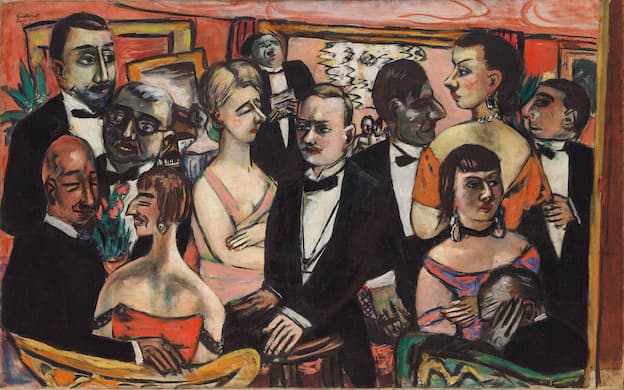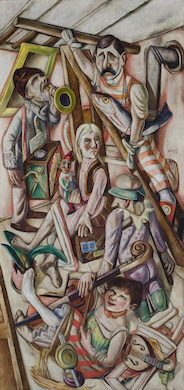Even Though These Are Max Beckmann’s ‘Formative Years,’ His Self-Portraits Are Formidable
After asking a friend why Beckmann’s bizarre imagery didn’t qualify him as a Surrealist, she responds immediately: ‘Because the world is too real for him.’ Exactly. Meet Max Beckmann, chronicler of times that are perpetually in crisis.

The German painter Max Beckmann (1884-1950) is likely best known for a series of sizable triptychs, canvases whose clustered images channel the medieval, the modern, the mythical, and the mundane. Many New Yorkers are best acquainted with him, in that regard, through “Departure” (1932/’33-’35), long a staple of the Museum of Modern Art’s permanent collection and as disjunctive an accounting of cultural dislocation as you could hope for — or withstand.
Beckmann is also known for his formidable self-portraits, not a few of which can be seen in “Max Beckmann: The Formative Years, 1915-25,” a recently opened exhibition at the Neue Galerie. With that aggressive sweep of forehead and tight turn of mouth, Beckmann typically pictured himself facing down the viewer, stolid in bulk and blunt in demeanor. Dressing up as a sailor, as he does in “Self-Portrait with White Cap” (1926), is the closest he came to being light-hearted.
That isn’t to say Beckmann lacked a sense of humor. At the bottom right of “Paris Society” (1925/1931/1947) is a man covering his face in a gesture whose closest verbal equivalent might be “oy vey.” Beckmann’s widow Mathilde identified this figure as being a German ambassador, Leopold von Hoesch. But, really, take a look at that furrowed brow and tell me it isn’t Beckmann himself, mulling whether the company of his peers is a burden, a farce, or a gift.
This, in significant part, is how Beckmann viewed life itself. He bristled at being compared with the Expressionists. No slash-and-burn nihilism for Mr. Beckmann, thank you very much. “It’s stupid to love humanity,” he wrote, “but I love it anyway. I love its meanness, its banality, its dullness, its cheap contentment, and its oh-so-very-rare heroism.” When I asked a friend why Beckmann’s bizarre imagery didn’t qualify him as a Surrealist, she responded immediately: “Because the world is too real for him.” Exactly. Meet Max Beckmann, chronicler of times that are perpetually in crisis.

Beckmann was born at Leipzig, studied at Weimar and established himself as the “German Delacroix” upon reaching Berlin. Although steeped in art history and wary of fashion, he kept an eye on vanguardist figures like a fellow countryman, Louis Corinth, and an odd painter from Norway, Edvard Munch. Beckmann achieved renown as a young artist and then came World War I. He served as a medic, saw the damage wrought by the industrialization of combat, and suffered nervous exhaustion. After being discharged, Beckmann approached art-making in a different manner. How could he not?
The Neue Galerie show focuses on a period encompassing World War I and stops short of the rise of National Socialism — between, as critic Robert Hughes memorably put it, “the sleepwalk and the goose step.” Stylistically, we see Beckmann employ softly modeled forms in cloistered Boschean dioramas like “Women’s Bath” (1919) and “The Dream” (1921), with its up-ended conglomeration of amputees, street performers, and musical instruments. The hieratic, harshly outlined shapes that would characterize his later paintings are seen in “Paris Society,” a canvas that was reworked over the space of some 22 years.
Beckmann’s prolific output as a printmaker is on display with “Die Hölle (Hell)” (1919), a scabrous suite of etchings detailing the moral failings of Weimar Germany. The artist, ever urbane, pops in and out of these fractured portrayals of a society governed by excess, marked by poverty, and given to inevitable bouts of violence. Channeling the compositional strategies of Cubism, Beckmann’s bilious moralism is of a piece with similar meditations on civilization’s failings by contemporaries like George Grosz and Otto Dix.
His paintings are more distinctive and, I think, more profound, not least because they don’t capitulate to cynicism and self-righteousness. However equivocal Beckmann may have felt about humankind, his work is marked by a rapacious appetite for life. Even within the most enigmatic or caustic of scenarios, there are moments marked by empathy and hope. Here was a man who, after having later been driven out of his native Germany by a regime that dubbed his art “degenerate,” had the wherewithal to aver that “human sympathy and understanding must be reinstated … in the midst of a boundless world turmoil.”
No Pollyanna, our Max, but neither was he a fatalist. As invested as he was in limning the boundlessness of history and its abundant cruelties, Beckmann could not help but take note of the comedy inherent in fashion, the pleasures of sensual lassitude, the foibles of human congress, and a hot air balloon gliding gently on the air as if it were a visitor from on high. There are few artists, let alone modern artists, who achieve the goal of realizing the “fullness, roundness, and the vitally pulsing” nature of “essential things.” Max Beckmann was one of them. “The Formative Years” is a must-see exhibition.

